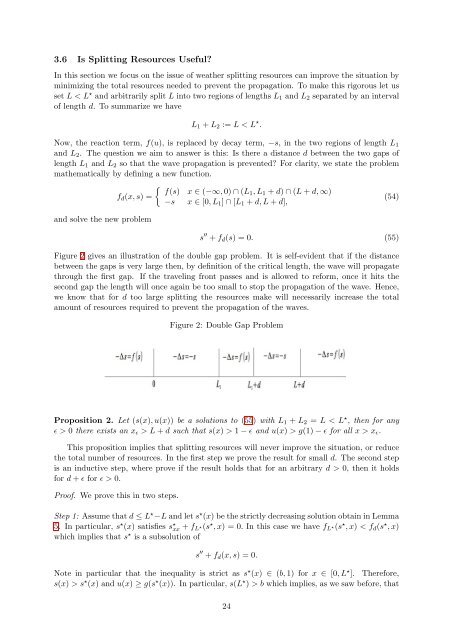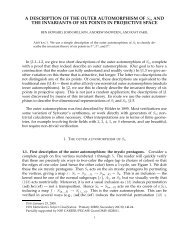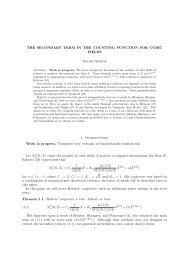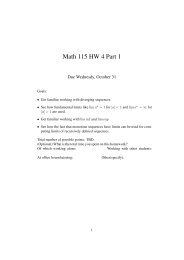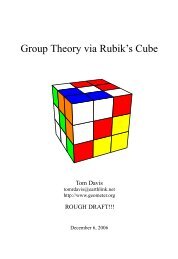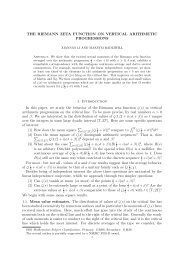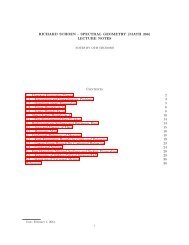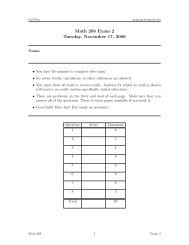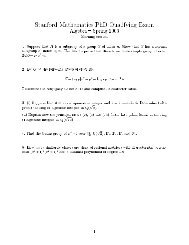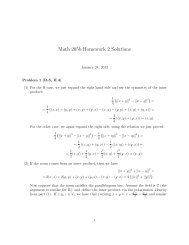Traveling Wave Solutions in a Reaction-Diffusion Model for Criminal ...
Traveling Wave Solutions in a Reaction-Diffusion Model for Criminal ...
Traveling Wave Solutions in a Reaction-Diffusion Model for Criminal ...
Create successful ePaper yourself
Turn your PDF publications into a flip-book with our unique Google optimized e-Paper software.
3.6 Is Splitt<strong>in</strong>g Resources Useful?<br />
In this section we focus on the issue of weather splitt<strong>in</strong>g resources can improve the situation by<br />
m<strong>in</strong>imiz<strong>in</strong>g the total resources needed to prevent the propagation. To make this rigorous let us<br />
set L < L ⋆ and arbitrarily split L <strong>in</strong>to two regions of lengths L1 and L2 separated by an <strong>in</strong>terval<br />
of length d. To summarize we have<br />
L1 + L2 := L < L ⋆ .<br />
Now, the reaction term, f(u), is replaced by decay term, −s, <strong>in</strong> the two regions of length L1<br />
and L2. The question we aim to answer is this: Is there a distance d between the two gaps of<br />
length L1 and L2 so that the wave propagation is prevented? For clarity, we state the problem<br />
mathematically by def<strong>in</strong><strong>in</strong>g a new function.<br />
<br />
f(s) x ∈ (−∞, 0) ∩ (L1, L1 + d) ∩ (L + d, ∞)<br />
fd(x, s) =<br />
(54)<br />
−s x ∈ [0, L1] ∩ [L1 + d, L + d],<br />
and solve the new problem<br />
s ′′ + fd(s) = 0. (55)<br />
Figure 2 gives an illustration of the double gap problem. It is self-evident that if the distance<br />
between the gaps is very large then, by def<strong>in</strong>ition of the critical length, the wave will propagate<br />
through the first gap. If the travel<strong>in</strong>g front passes and is allowed to re<strong>for</strong>m, once it hits the<br />
second gap the length will once aga<strong>in</strong> be too small to stop the propagation of the wave. Hence,<br />
we know that <strong>for</strong> d too large splitt<strong>in</strong>g the resources make will necessarily <strong>in</strong>crease the total<br />
amount of resources required to prevent the propagation of the waves.<br />
Figure 2: Double Gap Problem<br />
Proposition 2. Let (s(x), u(x)) be a solutions to (55) with L1 + L2 = L < L ⋆ , then <strong>for</strong> any<br />
ɛ > 0 there exists an xɛ > L + d such that s(x) > 1 − ɛ and u(x) > g(1) − ɛ <strong>for</strong> all x > xɛ.<br />
This proposition implies that splitt<strong>in</strong>g resources will never improve the situation, or reduce<br />
the total number of resources. In the first step we prove the result <strong>for</strong> small d. The second step<br />
is an <strong>in</strong>ductive step, where prove if the result holds that <strong>for</strong> an arbitrary d > 0, then it holds<br />
<strong>for</strong> d + ɛ <strong>for</strong> ɛ > 0.<br />
Proof. We prove this <strong>in</strong> two steps.<br />
Step 1: Assume that d ≤ L ⋆ −L and let s ⋆ (x) be the strictly decreas<strong>in</strong>g solution obta<strong>in</strong> <strong>in</strong> Lemma<br />
5. In particular, s ⋆ (x) satisfies s ⋆ xx + fL ⋆(s⋆ , x) = 0. In this case we have fL ⋆(s⋆ , x) < fd(s ⋆ , x)<br />
which implies that s ⋆ is a subsolution of<br />
s ′′ + fd(x, s) = 0.<br />
Note <strong>in</strong> particular that the <strong>in</strong>equality is strict as s ⋆ (x) ∈ (b, 1) <strong>for</strong> x ∈ [0, L ⋆ ]. There<strong>for</strong>e,<br />
s(x) > s ⋆ (x) and u(x) ≥ g(s ⋆ (x)). In particular, s(L ⋆ ) > b which implies, as we saw be<strong>for</strong>e, that<br />
24


